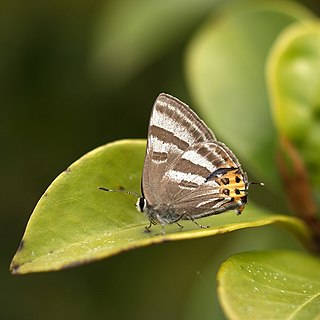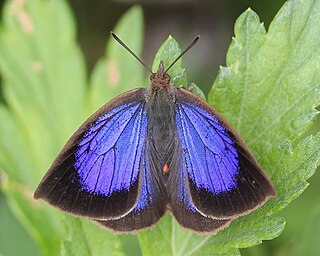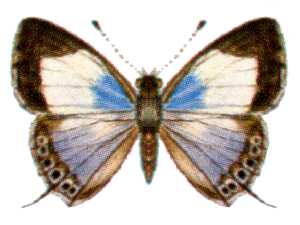
Lycaenidae is the second-largest family of butterflies, with over 6,000 species worldwide, whose members are also called gossamer-winged butterflies. They constitute about 30% of the known butterfly species.

The Nymphalinae are a subfamily of brush-footed butterflies. Sometimes, the subfamilies Limenitidinae, and Biblidinae are included here as subordinate tribe(s), while the tribe Melitaeini is occasionally regarded as a distinct subfamily. Their phylogenetics can be traced back to the Cretaceous Terrestrial Revolution after the Cretaceous-Paleogene (K-Pg) mass extinction, followed by repeated dispersals into the rest of the Old World and the New World during various periods beginning in the Eocene.

Lycaeninae, the coppers, are a subfamily of the gossamer-winged butterflies (Lycaenidae).

The subfamily Theclinae is a group of butterflies, often referred to as hairstreaks, with some species instead known as elfins or by other names. The group is part of the family Lycaenidae, the "gossamer-winged butterflies". There are many tropical species as well as a number found in the Americas. Tropical hairstreaks often have iridescent blue coloration above, caused by reflected light from the structure of the wing scales rather than by pigment. Hairstreaks from North America are commonly brown above. Few Theclinae are migratory. Members of this group are described as 'thecline'.

Polyommatinae, the blues, are a diverse subfamily of gossamer-winged butterflies.

The Eumaeini are a tribe of gossamer-winged butterflies. They are typically placed in the subfamily Theclinae, but sometimes considered a separate subfamily Eumaeinae. Over 1,000 species are found in the Neotropical realm

The Luciini are a tribe of butterflies in the family Lycaenidae.

The Arhopalini are a rather small tribe of butterflies in the family Lycaenidae.

The Zesiini are a small tribe of butterflies in the family Lycaenidae.
The Hypotheclini are a small tribe of butterflies in the family Lycaenidae.

The Cheritrini are a small tribe of butterflies in the family Lycaenidae; they contain the imperials and allies. Their closest living relatives seem to be the Horagini; indeed, the genus Ahmetia was in the past often placed there.

The Deudorigini are a tribe of butterflies in the family Lycaenidae.

The Aphnaeinae are a subfamily of butterflies in the family Lycaenidae.

Arhopala is a very large genus of gossamer-winged butterflies (Lycaenidae). They are the type genus of the tribe Arhopalini. In the relatively wide circumscription used here, it contains over 200 species collectively known as oakblues. They occur from Japan throughout temperate to tropical Asia south and east of the Himalayas to Australia and the Solomon Islands of Melanesia. Like many of their relatives, their caterpillars are attended and protected by ants (myrmecophily). Sexual dichromatism is often prominent in adult oakblues.

Caleta is a genus of butterflies in the family Lycaenidae, mainly found in Southeast Asia. The common name Pierrot is used for some species.

Horaga is a genus of butterflies in the family Lycaenidae which John Nevill Eliot, 1973, places in the tribe Horagini of the subfamily Theclinae. The wings are blue, purple or brown above, with broad black costal and distal margins and usually a white discal spot on the forewing. The female is dingier than the male. The underside is ochreous, or ochreous brown, with a dark postdiscal line on both wings outwardly edged with white, this edging forming a broad white band not continued much above vein 6, on the forewing, but narrower and outwardly diffuse on the hindwing. The hindwing bears filamentous tails at veins 1b, 1 and 3 and, beneath. The pattern of H. araotina is aberrant.

Ahmetia achaja is a species of butterfly in the family Lycaenidae. It belongs to the monotypic genus Ahmetia, formerly known as Cowania. It is sometimes assigned to the tribe Horagini, but it is more probably a member of the closely related Cheritrini. It is found in Thailand and Vietnam.

Jameela is a genus of butterflies in the family Lycaenidae.

Tarucus rosacea, the Mediterranean Pierrot or Mediterranean tiger blue, is a butterfly in the family Lycaenidae. It is found in Mauritania, Senegal, the Gambia, Guinea, Burkina Faso, northern Ivory Coast, northern Ghana, northern Nigeria, Niger, northern Cameroon, Chad, Sudan, Ethiopia, northern Uganda, north-western Kenya, Somalia, Djibouti and Arabia. The habitat consists of Sudan savanna and the Sahel.
Leptotes sanctithomae is a butterfly in the family Lycaenidae. It is found on São Tomé Island. The type locality is the settlement of São Nicolau, Mé-Zóchi District. It was described by Emily Mary Bowdler Sharpe in 1893.


















